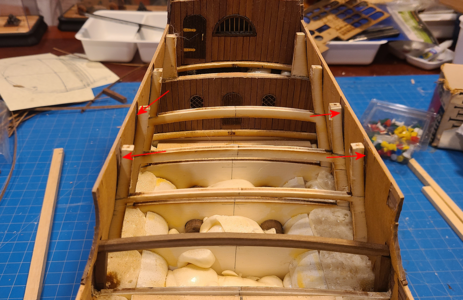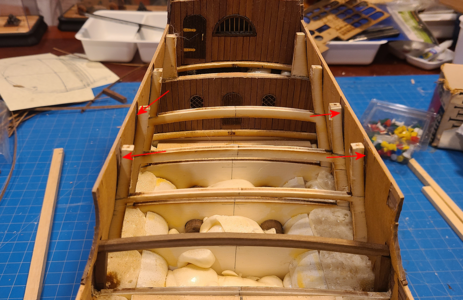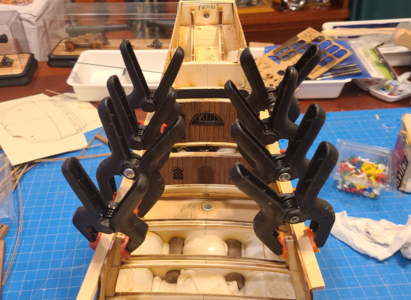As you all know, wetting a white glue joint on wood will soften the white glue and allow the joint to be disassembled (standard white glue, not the waterproof kind). This fact has saved me a number of times.
On a section of the hull I am building, I have 1.5x4mm walnut strips laminated to 1/64" veneer, and will later be adding 0.6mm walnut to the opposite side. During gluing of the first two layers, while holding them against bulkhead sections which are to be removed later, it appeared to dry well, but when the clamps were removed, areas no longer supported/attached to the bulkheads tend to bow out. Maybe glue contraction or expansion or something, I don't know.
I know I can put a bend in wood by wetting it and clamping it in the desired position. And I know I can soften a joint with white glue, as explained above. My question is: If I dampen the strips and veneer, which are glued together with Elmer's wood glue, which will soften the glue and the wood, and clamp them in the proper position, when dry will the bond lose any or all of its strength? Or, will it stay strong, just hopefully in a more appropriate position? I hope it's just the second one, as I just tried it on my model, but I thought I'd ask anyhow.
Here is a pic of the warped areas:

After wetting the areas that appear warped (turning some of the surface white glue white again), I clamped it in the correct position, and hope that overnight it will stay in place, AND be strong enough:

I think I will make some sort if removable and temporary ties from one side of the hull to the other, in this area, so that while gluing other items (like the inside planking), it may better stay in place.
On a section of the hull I am building, I have 1.5x4mm walnut strips laminated to 1/64" veneer, and will later be adding 0.6mm walnut to the opposite side. During gluing of the first two layers, while holding them against bulkhead sections which are to be removed later, it appeared to dry well, but when the clamps were removed, areas no longer supported/attached to the bulkheads tend to bow out. Maybe glue contraction or expansion or something, I don't know.
I know I can put a bend in wood by wetting it and clamping it in the desired position. And I know I can soften a joint with white glue, as explained above. My question is: If I dampen the strips and veneer, which are glued together with Elmer's wood glue, which will soften the glue and the wood, and clamp them in the proper position, when dry will the bond lose any or all of its strength? Or, will it stay strong, just hopefully in a more appropriate position? I hope it's just the second one, as I just tried it on my model, but I thought I'd ask anyhow.
Here is a pic of the warped areas:

After wetting the areas that appear warped (turning some of the surface white glue white again), I clamped it in the correct position, and hope that overnight it will stay in place, AND be strong enough:

I think I will make some sort if removable and temporary ties from one side of the hull to the other, in this area, so that while gluing other items (like the inside planking), it may better stay in place.





